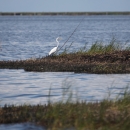History
On or before March 17, 2014, a 20-inch diameter pipeline, owned by the Mid-Valley Pipeline Company and operated by Sunoco Logistics Partners, L.P. (“Sunoco”)/Energy Transfer Partners (ETP), ruptured discharging approximately 500 barrels (~21,000 gallons) of crude oil into a small stream and subsequently into a wetland within the Oak Glen Nature Preserve (Preserve) and adjacent properties located in Colerain Township, Hamilton County, Ohio. The spill and subsequent clean-up operations impacted the stream, vernal pool, forested wetland, and adjacent areas.
The headwater stream provides habitat for migratory birds, the Indiana bat (Myotis sodalis), the northern long-eared bat (Myotis septentrionalis), critical habitat for the state endangered cave salamander (Eurycea lucifuga), and other amphibians. The tributary, wetland, and associated habitats were degraded by the Mid-Valley Pipeline oil spill. Additional injuries were caused by the emergency response phase of the cleanup, including damage to habitat for the State endangered Lark Sparrow (Chondestes grammacus) via the construction of roads. This discharge adversely affected natural resources within the Trustee jurisdiction of the United States and the State of Ohio.
Trustees
The Trustees for the Site, acting on behalf of the public, include the Department of the Interior acting by and through its representative the U.S. Fish and Wildlife Service, and the Ohio Environmental Protection Agency.
The U.S. Fish and Wildlife Service is in the process of updating webpages, so some content that was previously available is temporarily unavailable. Please contact the Ohio Ecological Services Field Office for additional information.


